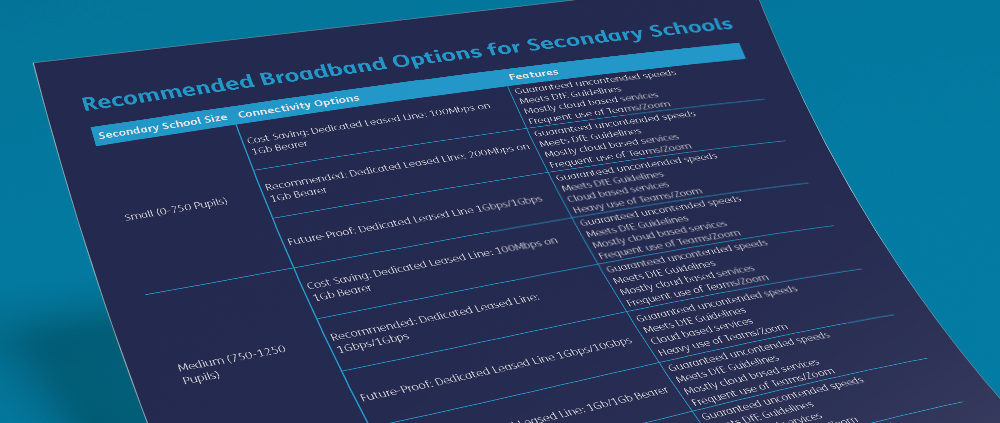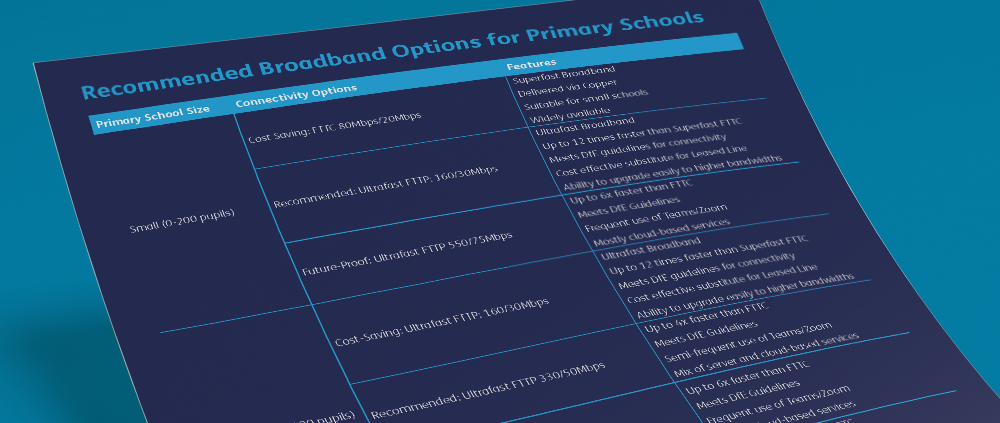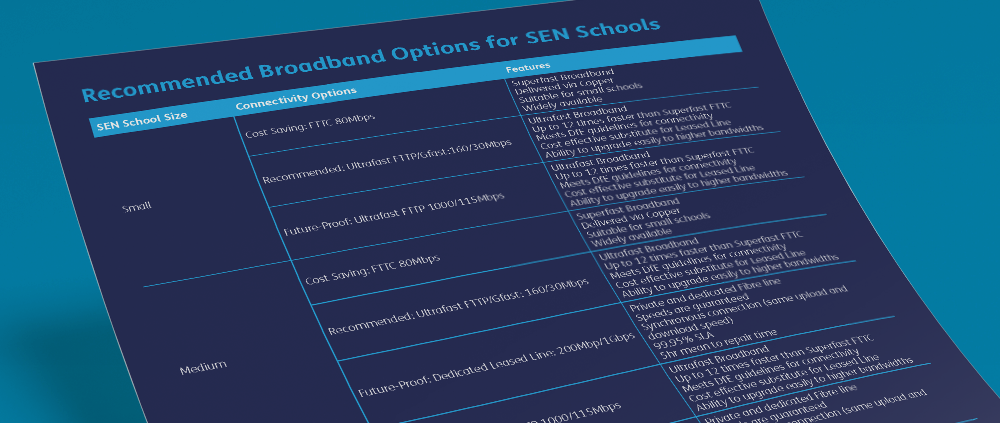Understanding the different types of broadband and their associated speeds is crucial for ensuring your school stays connected and runs efficiently. A reliable, high-speed broadband connection is the backbone of seamless operations for every successful school in the country, so it’s important you make the right choice.
In this guide, as well as looking at what makes a good broadband provider, we’ll explore the many broadband options available, which connectivity types meet the DfE standards, we’ll look at upload and download speeds and what you need to consider, as well as general speeds recommended for different school sizes. First, let’s take a look at the DfE Broadband Standards.
DfE Broadband Standards
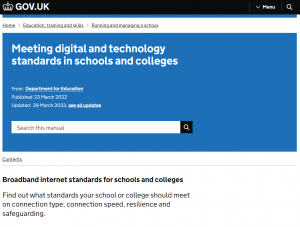
In March 2022 the DfE set minimum broadband standards as guidelines for schools when choosing the right digital infrastructure and technology. The standards state that all schools should use a full fibre connection for their broadband service or upgrade to fibre at the earliest opportunity.
Primary school broadband connections should meet a minimum 100Mbps (Megabits per second) download and 30Mbps upload, with the capacity to deliver 1Gbps (1000Mbps) as demand on your broadband service increases. All secondary schools are required to have a 1Gbps (Gigabit per second) capacity, however this should be capable of providing the same symmetrical upload and download speed). Depending on the size of your secondary school and its broadband usage levels, you may well need more than 1Gbps. Connections are available up to 10Gbps.
An additional resilient backup connection of a different type to your main internet connection should also be installed. The standards also state a firewall is required as part of the school’s internet and network system.
Types of Broadband: Unravelling the Options
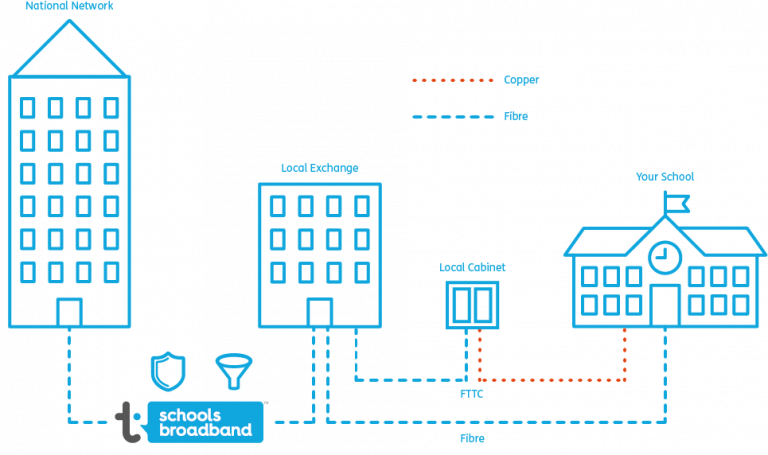
ADSL is one of the oldest broadband connection types, delivered over the UK’s copper telephone network and will be fully phased out by December 2025. It is the slowest broadband available and typically delivers speeds up to 24Mbps. It is no longer suitable as a primary connection in any type of school, as demand on digital services has now outgrown this technology. Any school that still has an ADSL connection, should look to upgrade as soon as other options are available in your area. This does not meet the DfE Minimum Broadband Standards. Please check with us for more details.
FTTC (Superfast Broadband) uses fibre optic cables that go from the local exchange as far as the green street cabinet. The final connection to your premises is delivered from the street cabinet using copper (which is currently being phased out; last orders were September 2023 being fully phased out by December 2025). This provides faster broadband than ADSL, delivering up to 80Mbps download and 20Mbps upload; minimum guaranteed speeds are provided and can be checked at BT ADSL Checker. FTTC used to be recommended for small to mid-sized schools looking for faster speeds to ADSL, though this connectivity type does not meet the DfE standards that were set in March 2022. You should look to upgrade an FTTC connection as soon as other options are available in your area. Please check with us for availability.
EoFTTC is very similar to FTTC, however unlike FTTC, 20Mbps of the 80Mbps download speed is guaranteed, and has a slightly higher service level agreement than FTTC. It should be noted this connectivity type also does not meet the DfE recommended standards set in March 2022, though it is acceptable if FTTP (see below for details) is not yet available in the area. NB. If you are signing any contracts for this service, do not sign any long-term contracts without ensuring it includes a free upgrade to FTTP when it becomes available. Schools Broadband provides free upgrades for all FTTC/EoFTTC customers as soon as FTTP (full fibre services) become available in your area. Please ask for more details.
Prior to the availability of SoGEA, (Single Order Generic Ethernet Access), to deliver broadband to any building, installation of a traditional phone line was required in addition to ADSL and FTTC broadband.
A SoGEA connection now means there is no requirement to install a traditional copper phone line as SoGEA includes an underlying version of a phone line itself, although this can only be used for data and not telephone services. A VoIP phone service therefore will be required in this instance rather than an analogue phone. All PSTN (phone) services will have to transition to VoIP after the traditional copper phone line (PSTN, Public Switch Telephone Network) cessation in December 2025. VoIP phone services can run over all fibre connections such as FTTP, Full Fibre and Leased Lines. SoGEA costs less than the combined costs of a phone line and standard broadband package, plus there are savings to be had using a VoIP phone service too.
SoGEA is the transition connectivity solution used where traditional phone lines or PSTN networks are ceasing service as part of BT’s network upgrade and where FTTP is not yet available.
SoGEA speeds range from 40Mbps/10Mbps and reach up to 330Mbps/50Mbps using the SoGfast variant. Please contact us for more details about SoGEA services.
FTTP (Ultrafast Broadband) is one of the newest broadband technologies available. This is a full fibre connection with fibre connecting from the local exchange directly to your premises e.g. Fibre to the Premise (FTTP). It provides broadband download speeds starting at 100Mbps and is quick and easy to upgrade to faster speeds up to 1000Mbps (download) if required. Whilst FTTP speeds are not guaranteed, because schools demand bandwidth at quieter times of the day, this does not usually impact performance. FTTP upload speeds are dependent upon the service obtained. In general, the current popular options are; 160/30Mbps, 330/50Mbps, 550/75Mbps and 1000/115Mbps. Please note that the first number is the potential download speed and the second number is the potential upload speed.
The versatility of FTTP means it is ideal for primary schools of varying sizes. Significantly better value than leased lines of the same speed and FTTP fully meets the DfE Broadband Standards for primary schools. FTTP is also ideal as a separate backup line for very large primary schools and secondary schools alike. Please be aware that FTTP does not provide symmetrical upload and download speeds, and therefore this type of connectivity does not meet the DfE Broadband Standards for secondary schools to use as a primary connection.
You will need to check availability of FTTP as it is part of the Government’s Gigabit Capable Broadband project, which is in the process of being rolled out, to hard-to-reach areas. Please check with us for more details.
Recently over 100 new alternative network providers, known as “AltNets” have been building full fibre networks in competition with the traditional carriers such as BT and Virgin. Their full fibre connections provide lightning-fast speeds from 100Mbps all the way up to 10Gbps at more favourable prices than traditional leased line connections. Whilst services vary from ‘AltNet’ to ‘AltNet’ with regards to guaranteed download and upload speeds, along with contention, this is certainly a more economical way of achieving high-speed connectivity. They are a future-proof connection for schools, providing flexibility to increase speeds quickly and easily as your broadband & cloud usage increases. Suitable as a main broadband connection or failover line depending on the size of your school. Please check for availability.
Leased lines also provide speeds from 100Mbps to 10Gbps (Gigabits per second), where all speeds are guaranteed with a 99.95% service level agreement. Whilst leased lines are the costliest of all connections, they come with symmetrical speeds are uncontended and provide superior reliability. They are suitable for medium to large schools with high data traffic e.g. cloud services, and reliability demands. Available everywhere, though are subject to site a survey. Please ask for more details.
Understanding Upload and Download Dynamics
Download Speed
The download speed is the rate at which data is transferred from the internet to your school’s router. This is not the speed at which a device on your network can access the internet, as there may be many factors that affect data transfer speeds on a school network e.g. core and hub switches, wireless technology, device technology to name a few. This is important as many factors may affect the speed of downloading files, accessing websites, and streaming content.
Upload Speed
The upload speed is the rate at which data is sent from your school’s network to the router. Actual speed principles as per download, also applies. Upload speed is crucial for activities like video conferencing, uploading content to the cloud, and running online collaborative platforms.
Recommended Speeds for Different School Sizes
Recommended connection types and speeds will depend on several factors such as; number of devices accessing the internet at any given time. If you are heavy users of the cloud, or plan to move to cloud services. If you live stream video for teaching or have a percentage of students using 1:1 devices for example, all this should be factored in to your planning stage when choosing the right connection. Whilst it is always best to get professional guidance, you may want to visit one of our broadband guides as a starting point.
Quick Quotes
By visiting our online Quick Quote service, you can input your school size and other variables to obtain a quick draft estimate in under 60 seconds. Please note this is indicative only and should always be followed up with a consultation if you wish to explore your options further to ensure all your requirements have been taken into consideration.
Considerations for Business Managers when Choosing Broadband Service and Provider
Analyse your school’s current internet usage patterns to determine the required speed.
Please contact us if you need help with this.
Anticipate any growth requirements such as the size of your school, whether you plan to increase the use of the internet in lessons, if you plan to increase the number of devices on your network, or whether your back-office functions are likely to make more use of cloud services. Ensure your chosen connection type can accommodate future needs.
Balance performance requirements and meeting DfE recommended standards with budget constraints. Generally, FTTP offers the best value broadband up to 1000Mbps so good for primary schools; for budget conscious secondary schools a full fibre connection would be advisable if full fibre is available. The speeds and guarantees will determine the cost.
Prioritise specialist education Internet Service Providers who can provide robust internet security, (the amount of data schools hold make them targets for cyber criminals), cloud hosted firewalls and specialist education web filtering and safeguarding services. Check to see if providers’ services can support your DfE compliances and KCSiE 2023 obligations and check to see if they are on one of the major DfE approved frameworks such as Crown Commercial Services (CCS) or Yorkshire Purchasing Organisation (YPO). In addition, other frameworks such as Everything ICT, enFrame ICT and Crescent Purchasing Consortium also offer access to connectivity procurement frameworks. Frameworks provide you with a cost effective and legal way of procuring important goods and services for your school or Trust, knowing they have already been through a rigorous vetting process. Currently only CCS and YPO are officially approved DfE procurement routes for connectivity. Though all frameworks are a fast, easy-to-use procurement service, removing the need to undertake lengthy time-consuming and costly tendering processes of your own.
When contacting providers for quotes, we recommend using our handy checklist of questions to ask to make sure you’re getting the right service for your school.

